Fun Facts
Want some more interesting facts about the Proserpinus clarkiae?
*Member of the Sphingidae family
*Wingspan is from 3-3.8 centimeters (Butterflies and Moths of
North America 2014 and Macromoths of Northwest
Forests and Woodland 2013).
*Moths have such impressive hearing that a male moth can
smell a female moth that is rougly seven miles away (Live
Science 2012).
*Interestingly enough, some adult moths do not have a mouth,
therefore do not eat (Project InSECT LLC 2009).
*Many moths have the awesome ability to mimic other insects
to avoid being eaten by predators.
*Moths can vary from the size of a pencil tip up to the size
of a typical bird (Live Science 2012).
Why should you care about the Clark's
Sphinx Moth?
There is an estimated 150-250,000 different species of
moths (Butterflies and Moths of North America 2014). This does not
include plenty that are still undiscovered. Moths are a huge part of
biodiversity and an even bigger part to the ecosystem. If moths were
eliminated, this would cause a huge problem for other wildlife.
Moths feed on nectar which helps pollinate other flowers and at
times, helps with plants evolving. Moths are also considered food
for many other organisms. If moths were eliminated from the
environment, it would cause a drastic change in the environment. The
Proserpinus clarkiae adds to the biodiversity in the ecosystem.

Why did we choose this organism?
We chose to make our website about the
Clark's Sphinx Moth from a wide varitety of organisms spread
throughout our professor's
study system. Our professor, Dr. Thomsen, started with all
grassland species and works as part of the Angelo Reserve. Our
organism came from different species that are listed on the
Angelo Reserve website. When given the list of these organisms,
we at first did not know what any of these organisms were. We
were extremely interested in the moth because neither one of us
had ever heard of it before. This gave us the ability to reasearch
the organism and become more familiar with the incredible
Clark's Sphinx! To see more of these organisms from this
website and more organisms that my professor studies,
click
here.
Continue on to see our references
or click back to home.